April 19, 2010
Provost’s Undergraduate Research Awards
PURA grants in hand, 44 JHU undergrads pose provocative questions
In research, the journey from point A to point B sometimes leads the individual to C, D or E. The trip, however, typically begins with a question.
Here are a few: Does sustained listening to an MP3 player via earphones have a negative impact on hearing? What mathematical secrets can be gleaned from a Bulgarian solitaire game? How has small-scale gold mining impacted the health of Mongolian miners?
These queries formed the basis of three out of the 40 projects carried out in summer and fall 2009 by 44 students who received Provost’s Undergraduate Research Awards to support their work. Many students use the awards—of up to $2,500—to take their maiden research journeys.
On Tuesday, April 20, Lloyd B. Minor, provost and senior vice president for academic affairs, will host the 17th annual PURA ceremony to honor their achievements.
The awards are open to students in each of the university’s four schools with full-time undergraduates: the Krieger School of Arts and Sciences, the Whiting School of Engineering, the Peabody Conservatory and the School of Nursing.
Since 1993, 752 PURA grants have been awarded for students to conduct original research, some results of which have been published in professional journals or presented at academic conferences. The awards, funded through donations from the Hodson Trust, are an important part of the university’s mission and its commitment to research opportunities for undergraduates. In total, the Hodson Trust has contributed more than $3.5 million in both operating and endowment support to the PURA program.
Scott Zeger, vice provost for research, said that the awards make it possible for dozens of students each year to undertake “first-rate,” important projects.
“The Johns Hopkins undergraduate experience is unique in the country because of the extent to which learning is built around discovery, both intellectual and personal,” Zeger said. “Johns Hopkins encourages every student to undertake a research or scholarship project with a faculty mentor chosen from anywhere in the university. PURA helps to make this possible. It is hard to choose among the more than 100 applications we receive each year. Our goal is to grow the PURA support so that more students can win awards.”
The 2010 ceremony will be held in the Glass Pavilion at Homewood. The entire Johns Hopkins community is invited to the event, which begins at 3 p.m. with an informal poster session allowing students to display and talk about their projects. A recognition ceremony hosted by Provost Minor will begin at 4:30 p.m. and will include a student performance.
See What They Found Out
To recognize the recipients of the 2009 Provost’s Undergraduate Research Awards, an event will be held on Tuesday, April 20, in Homewood’s Glass Pavilion.
A poster session in which students will have an opportunity to display the results of their research begins at 3 p.m.
At the 4:30 p.m. recognition ceremony hosted by Lloyd Minor, provost and senior vice president for academic affairs, the honorees will be introduced by Scott Zeger, chair of the selection committee.
Minor will present the students’ certificates, and PURA recipient Brian Barone, a classical guitarist and a junior at the Peabody Conservatory, will perform. Barone will play a selection from the Mexico City Cathedral Manuscript A1823, thought to be composed by José María Bustamante (1777–1861), that he found doing his research.
A reception will follow at approximately 5:15 p.m. The entire Johns Hopkins community is invited.
Cards and number theory
Name: Calum Spicer
Age: 19
Hometown: Columbia, Md.
Majors: math and philosophy, Krieger School of Arts and Sciences
Faculty sponsor: Fred Torcaso, senior lecturer in Applied Mathematics and Statistics, Whiting School of Engineering
Project title: “Bulgarian Solitaire Games”
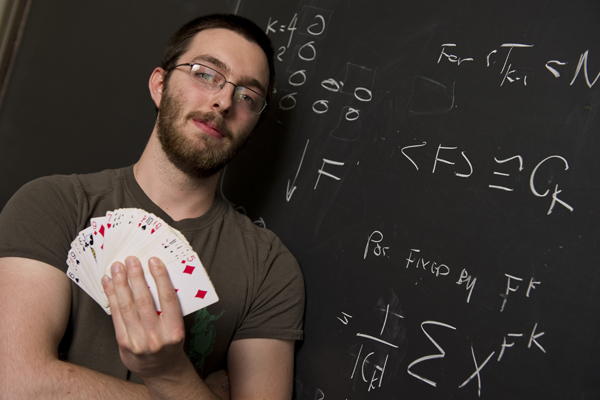
Though he’s showing his hand here the old-fashioned way, math and philosophy major Calum Spicer ‘played’ Bulgarian solitaire in his head or on a computer in an attempt to fully describe the cyclic behavior of the game. Will Kirk/Homewoodphoto.jhu.edu
Calum Spicer, a 19-year-old sophomore from Columbia, Md., is unraveling the mathematics of a card game called Bulgarian solitaire, whose peculiar properties have fascinated scholars since the game was introduced in 1983 by recreational mathematician Martin Gardner. Spicer’s findings have impressed his faculty sponsor, Fred Torcaso, who is encouraging him to write up his work for submission to a mathematical journal.
Questions for Calum Spicer:
Your research concerned a card game called Bulgarian solitaire. How is this game played?
The game, which may be more accurately thought of as an algorithm, consists of taking a set of piles of cards, or coins or whatever, removing one card from each pile and forming a new stack with these cards. For the mathematically inclined, these are just partitions of integers. This “rule” is repeated indefinitely. Since the game can only exist in a finite number of states, the game will enter into a limit cycle.
In studying this game, what were you looking for, and what did you find?
We were hoping to fully describe the cyclic behavior of the game. Interestingly, in answering this question, we found some deep connections between the game and combinatorics [the study of counting objects], abstract algebra and various number theoretical concepts such as the factorization of integers.
Where do you go from here?
A natural direction would be to “give back” to the various mathematical disciplines we have utilized and see if our knowledge about Bulgarian solitaire provides a new perspective on or insight into these fields of study. Bulgarian solitaire is an intuitive mathematical object, and having this in hand while exploring less obvious notions might be of use.
What did your fellow students think when they saw you playing with old-fashioned playing cards instead of the latest video game?
I did most of the “playing” in my head or using a computer program, so my peers were fortunately oblivious to my study involving something as antiquated, and embarrassing, as little paper rectangles.
Could your playing card research help someone do better at a Las Vegas casino?
Not unless you go to some strange casinos.
Sponsor Fred Torcaso says:
Calum has done some truly wonderful work. He has made significant progress in our understanding of how the Bulgarian solitaire game works in a more general setting. Moreover, the results he was able to obtain tied this game to some very interesting quantities and ideas that arise in number theory. These connections were fairly unexpected and thus make his work more significant. Although the problems he has considered are primarily mathematical exercises, the connections he has made to number theory can give mathematicians alternative understanding of these fundamental ideas.
On the practical side, the game of Bulgarian solitaire can actually be “played” and therefore provides a concrete example to demonstrate some nice ideas in number theory.
—Phil Sneiderman
Poor minorities and mobility
Name: Tanya Lukasik
Hometown: Hicksville, N.Y.
Major: psychology and public health
Faculty sponsor: Stefanie DeLuca, associate professor, Department of Sociology, Krieger School of Arts and Sciences
Project title: “Mobile in Mobile, Ala.: Moving Up the Ladder of Social and Geographic Opportunity”
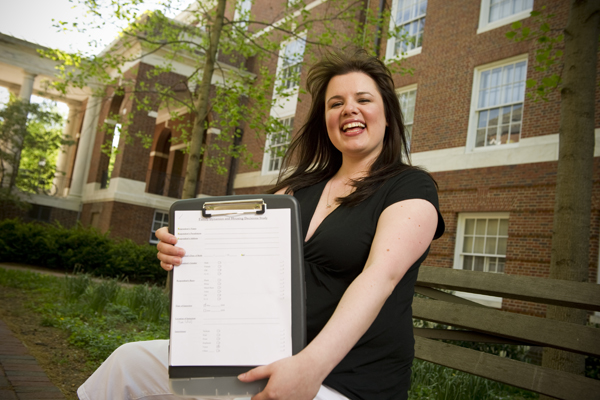
Tanya Lukasik and her clipboard spent a month last summer in Mobile, Ala. Photo: Will Kirk/Homewoodphoto.jhu.edu
Tanya Lukasik spent a month last summer in Mobile, Ala., interviewing heads of households, primarily mothers, from low-income minority families to determine how they are affected by residential mobility—everything from moving to a new home and switching children to a new school to changes in family structure associated with live-in romantic partners, marriage and divorce.
After recruiting participants by going door to door, Lukasik, a senior majoring in psychology and public health studies, interviewed individuals in 30 of the city’s most impoverished neighborhoods and public housing communities for the Adult Family Dynamics and Housing Decisions Study, under the guidance of her PURA adviser, Stefanie DeLuca. Lukasik will be returning to Mobile this coming summer with her research group, interested, she says, in “learning the process through which theory testing evolves into real, data-driven research.”
Questions for Tanya Lukasik:
Having previously conducted surveys only in a laboratory setting, how hard was it to approach strangers in their homes and ask personal questions?
The minutes leading up to my first interview were slightly anxiety-ridden, as the task in itself was quite nerve-racking, daunting and oddly intimidating. I was aware, for instance, that we would not be systematically observing neighborhood activity in the comfort of a protective, tinted-window sports utility vehicle like renowned sociologists Sampson and Raudenbush. I would be “cold calling” along with my research team members, walking through sight-unseen neighborhoods, clipboard in hand, knocking on doors to people’s homes, their private spaces, all within a foreign environment. Who would answer the door? Would they be unreceptive? Tell me to leave? By the time I arrived at the porch of “Margaret’s” home in the R.V. Taylor public housing community, all of my worries and concerns almost evaporated into the humid Mobile air. Sitting in the sun on her porch, Margaret intently listened to my rehearsed introductory greeting and agreed to participate; before I knew it, I was conducting my first sociological-based research survey, with an elderly Mobile native who was very friendly and eager to share her story. From that point on, everything else just fell into place.
Is there any particular interview that stands out?
I think I was most touched by Keoma, a woman from my home state of New York who had moved to Mobile in her early teens. While she tried to stay on the right track by doing well in school and obtaining a job after college, [she] got caught up with the wrong people, at the wrong time. However, she realized the error of her ways, persevered and eventually moved into public housing as a means of attempting to get back on her feet, along with her two children. She detailed her life story with such enthusiasm and contagious optimism, and always made sure to add important extra details to the questions I asked, and to include instructive stories, in an effort to help me understand the struggles she encountered, on an individual and neighborhood level, and to highlight things that could be improved. At the conclusion of her interview, she inquisitively asked, “What are you going to do with this, these stories?” At that moment, I truly realized the critical importance of the work we were doing. This wasn’t just about traveling to an unfamiliar area, meeting new people or filling out a packet of papers with predetermined questions. This was a chance not only to collect a combination of quantitative and qualitative data with significant policy relevance but also a unique opportunity to give a voice to those who are typically silenced and unheard.
Since you are now an expert at administering surveys, do you have any advice for the legions of U.S. Census workers who are about to go door to door across the country?
We often joked throughout our time in Mobile about how hard it must be for census workers to conduct surveys so methodically, quickly and with, we would assume, a level of indifference in an effort to avoid having their work transformed into hours-long interviews. When we prepared our surveys, we hadn’t anticipated that surveying individuals—especially those who were so geographically isolated and socially neglected—would be a time-consuming process, as they had such interesting stories to tell, inspiring narratives of overcoming hardship. Frequently our one-and-a-half-hour surveys would transform into three-and-a-half-hour qualitative interviews. I may actually consult with the U.S. Census Bureau next time around. It’s definitely a tough task without becoming too immersed in the stories you hear.
Sponsor Stefanie DeLuca says:
As part of my research team, Tanya collects interviews with families in some of the poorest communities in this country. Last summer, she took a leap of faith and came with us to Mobile, Ala., as the only undergraduate student in the group, and spent a month in some of the most violent and desperate communities that even I had ever seen. Her intellectual sharpness, moral compass, curiosity and work ethic are without bounds.
—Amy Lunday
Rhythm disorders in hearts
Name: Carolyn Park
Age: 20
Hometown: Baltimore
Major: biomedical engineering, Whiting School of Engineering
Faculty sponsor: Natalia Trayanova, professor of biomedical engineering, Whiting School of Engineering
Project title: “Role of Geometry and Ventricular Conduction Sensitivity to Sodium Current in Reentry Inducibility”
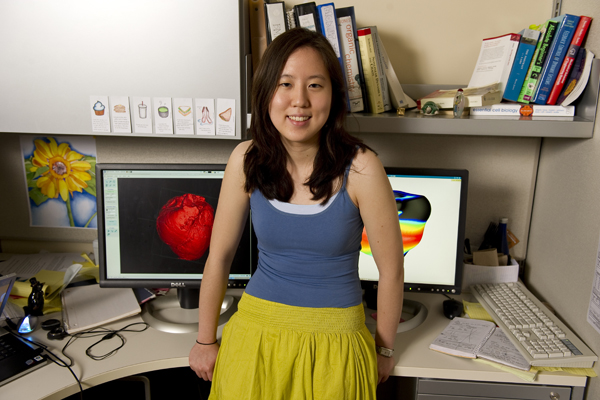
Carolyn Park is studying hearts with Brugada syndrome, a genetic disease. Photo: Will Kirk/Homewoodphoto.jhu.edu
Biomedical engineering major Carolyn Park’s project focused on rhythm disorders in hearts that have a genetic disease called Brugada syndrome. Her goal has been to understand the exact mechanisms by which these arrhythmias arise. In May, Park, a 20-year-old senior from Baltimore, will present her study, as first author, at a meeting in Denver of the Heart Rhythm Society, a prestigious meeting in the field. According to her faculty adviser, she will be the only undergraduate presenting at this meeting.
Questions for Carolyn Park:
Your research focuses on rhythm disorders in hearts that have a genetic disease called Brugada syndrome. How common is this disorder, and how dangerous is it to patients?
Brugada syndrome is also known as sudden unexpected death syndrome, and it is unfortunately common in young men, especially in Asian countries. Typically, a person suffering from this syndrome will die in his sleep from cardiac arrest. It is especially dangerous because patients almost always seem structurally fine, although their cardiac sodium channels may be defective. Luckily, clinical testing with certain drugs can reveal a trademark pattern in patients’ EKG recordings.
For your study, did you generate this rhythm disorder in animals or in a computer? What were you looking for, and what did you discover?
My goal was to find out why the syndrome only affects the right ventricle of the heart, since Brugada rhythm disorders clinically occur only in the right ventricle. To do so, I tested computer simulations using an accurate 3D rabbit heart model that was created from real heart data. What I found was that the normal structural differences between the left and right ventricles make the right ventricle more vulnerable to this disease. Specifically, the relative thinness of the right ventricular wall appears to be a key factor.
Where do you go from here?
I hope to run more tests to try to glean more information about the electrical properties of the tissue, and maybe generate EKG readings for the model to see if they match with clinical reports. I’m also considering repeating my experiments with a human heart model, which my lab has recently created. But frankly, I just want to get this published and move on because I’ve been working on it for three years. I’ve been accepted into the BME master’s program here. I’m planning on doing that for a year, and then hopefully I’ll get into med school.
Does this research help you give better advice to a friend who has a broken heart?
Yes, especially for my friends who happen to be rabbits. But they tend to recover quickly from a broken heart.
After a long day of studying heart rhythms, do you ever feel like you play drums in a rock band?
Well, my project investigates defective heart rhythms that are offbeat and out of sync at strange speeds. For some reason, whenever I try to play on a real drum set, I end up playing offbeat and out of sync at strange speeds.
Sponsor Natalia Trayanova says:
Carolyn is an unusual case. Normally, undergrads work with grad students or postdocs. This wasn’t the case with Carolyn. She had her own project that she was responsible for. She had to learn everything herself, formulate her hypotheses and do the research. Carolyn’s project has been very successful. Clearly, this is a project with important clinical implications.
—Phil Sneiderman
Technology and legal aid
Name: Kevin Park
Age: 21
Hometown: Niles, Ill.
Major: history and international studies/MA in history, Krieger School of Arts and Sciences
Faculty sponsor: Joel Grossman, Department of Political Science, Krieger School of Arts and Sciences
Project title: “Technological Innovation and the Status of Modern Civil Legal Aid in the U.K.”
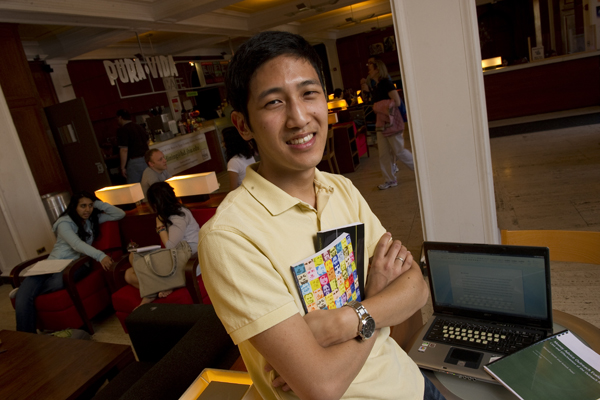
Kevin Park traveled to the U.K. for a comparison study of legal aid assistance. Photo: Will Kirk/Homewoodphoto.jhu.edu
After spending the summer of 2008 at the New York City Bar Justice Center studying the use of technology in the U.S. legal aid system, senior and history/international studies major Kevin Park, who is also a master’s degree candidate, wanted to find out whether the American model of telephone and Internet assistance for clients had any resonance across the pond. He chose the United Kingdom for his comparison study “because its legal system has many similarities to our own, often regarded as the closest,” he said.
He traveled to London to analyze the effect that legal aid telephone advice lines and Web sites have had on the legal system there, and to see how they have affected civil legal aid services from the perspectives of both government and private practitioners. Park also interviewed solicitors to gather qualitative data regarding the increasing use of technology in their field.
Questions for Kevin Park:
Compare the legal aid system in the U.K. with the U.S. system.
Call centers have been a staple in the English legal aid system since about 2000. Web sites and e-mail access are growing but are still in developmental stages. Other stuff like online chatting is being experimented with but not widely used. In-person meetings are still the preferred method because of existing limits in technology, although I think it is pretty safe to say that the number of people being assisted by these organizations has exponentially increased with the introduction of new technology and will continue to do so as the technology improves.
As for the U.S., the telephone and Internet innovations are pretty common, too, dating to around 1996. Part of my original idea was to figure out whether U.S. development of new technology had influenced English usage. That is why getting a clear picture of the English system was so essential.
When you embarked on your research, what were you looking for, and what did you find?
On the government side, there has been a significant increase in access to legal services through telephone, and smaller gains for Internet/e-mail. I found wide use of Internet/e-mail by solicitors, too, but can’t make any trend claims since this was the first time this type of data was collected.
The scope of usage depends on the technology. Telephone assistance is very common, especially in the government project. It comprises a pretty large portion of the client population. E-mail, on the other hand, is used mostly internally but not as often for starting inquiries. The Internet as a whole for finding information about legal aid—solicitors’ contact info, self-help manuals, etc.—is really small. Trend-wise, though, the first two are definitely growing, and the third is, too, but at a smaller rate.
Does your master’s thesis in history have any connection to your PURA work?
My master’s thesis is a broader study of intellectual exchange between the legal professions in the U.S. and England on the topic of civil legal aid over the course of the 20th century leading up to the present. I will be attending law school next year and plan on continuing work in international law.
Although the PURA project and master’s thesis covered the same topic, they approached the issue from disciplines with differing methodologies. I wanted to find a link between the two styles—political science vs. historical—and used the fieldwork in England to set myself up with a good foundation of knowledge in English civil legal aid. Ultimately, the PURA results did not make their way into the master’s essay.
Have you ever needed a lawyer yourself?
I have never needed a lawyer, but I have used mediation in a rent dispute. We resolved the issue before it got out of hand.
What’s your favorite legal drama and why?
My favorite legal drama would be Law and Order. It’s not the type of law that I see myself doing in the future, but the show always finds interesting topics. I’m not sure how realistic it is, though.
Any chance these innovations in law will facilitate the advent of online legal degrees in the future?
I don’t think that these innovations will facilitate online legal degrees but rather make communications or technology law part of the first-year curriculum. We’ve already seen changes in this regard in cases like constitutional law, which is now more commonly part of the standard first year than it used to be. Personally, I would be very suspicious of employing a lawyer who had an online degree just because there is so much information and the importance of practical training.
Sponsor Joel Grossman says:
Kevin Park is a terrific student. He has long been interested in the use of technology in providing civil legal aid services to indigents. He did a lot of preliminary work last year on civil legal aid in the United States, and his PURA grant enabled him to expand the scope of the project to legal services in Great Britain. Basing his work on interviews with British solicitors, and other sources of information, he found a high level of use of technology in the provision of legal services, both on behalf of the government and in services provided to litigants.
—Amy Lunday
Gold miners in Mongolia
Name: Halshka Graczyk
Age: 21
Hometown: Kingsville, Md.
Major: public health
Faculty sponsor: Ellen Silbergeld, professor, Environmental Health Engineering, Bloomberg School of Public Health
Project title: “The True Price of Gold: Examining Gender Disparities in Female Mongolian Miners”
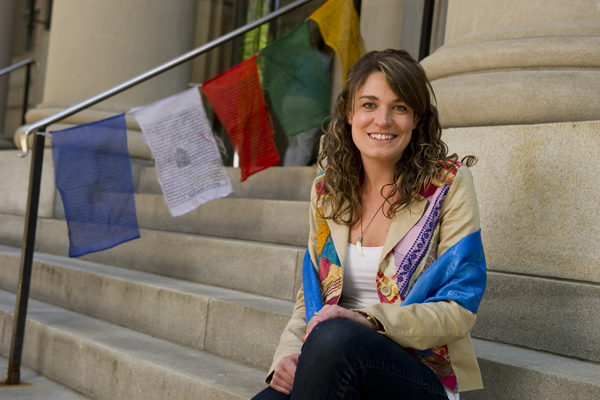 Halshka Graczyk understood that poverty-stricken Mongolians—many of them women and children—had turned to small-scale gold mining as a way of eking out a subsistence living, but she was concerned about the dangerous working conditions that many of the miners faced, including exposure to toxic levels of mercury. So Graczyk, a 21-year-old public health major from Kingsville, Md., traveled to Mongolia to examine those workers’ occupational health and safety. In that Central Asian country, she not only learned much about the lives of these workers but also had the opportunity to ride a camel and sup on fermented mare’s milk.
Halshka Graczyk understood that poverty-stricken Mongolians—many of them women and children—had turned to small-scale gold mining as a way of eking out a subsistence living, but she was concerned about the dangerous working conditions that many of the miners faced, including exposure to toxic levels of mercury. So Graczyk, a 21-year-old public health major from Kingsville, Md., traveled to Mongolia to examine those workers’ occupational health and safety. In that Central Asian country, she not only learned much about the lives of these workers but also had the opportunity to ride a camel and sup on fermented mare’s milk.
Questions for Halshka Graczyk:
What were you looking for, and what did you find?
My initial research aim was to investigate the occupational health and safety of women and children working in artisanal and small-scale gold mines throughout Mongolia. Artisanal miners utilize very high levels of the toxic chemical mercury in the gold extraction process and work in conditions that lack any sort of occupational safety standards.
I realized that despite the tremendous environmental and human health hazards associated with artisanal mining, this activity provided the sole means of livelihood for many of the nomadic communities I visited. As a purely poverty-driven activity, artisanal mining would continue to exist until alternative economic opportunities became available.
For this reason, I came to understand the ineffectiveness of the government’s stringent ban on mercury use in artisanal mining. At the conclusion of my research, I understood that although public health interventions aim to reduce exposure to hazardous contaminants, sometimes through regulatory bans, the unique cultural, economic and social factors that influence exposures must be thoroughly understood in order to effectively promote positive change.
What was the most interesting thing that happened to you?
I was living at a mining camp in northern Mongolia when one of the mining operators, in typical hospitable tradition, announced a feast to be held for me before my departure. I was honored, but my heart sank when I sat down to the table. Despite my limited Mongolian vocabulary, there was one word that I immediately recognized: boodog. At a public health conference a few weeks back, I was warned to stay away from boodog, a marmot dish, because the Mongolian marmot [editor’s note: a large ground squirrel] is a known host of the flea that carries bubonic plague. Understandably, I reached for the alternate dish, which was fresh fish caught from the local river—the river I knew was receiving the mine’s mercury tailings! Great, I thought, my options are bubonic-plague marmot or mercury-poisoned fish, and here I am, a public health student who cannot decline to eat because it would be unacceptably rude. However, at that table of welcoming, vibrant faces, my role as a researcher slowly faded and I realized I was just another hungry human being on this Earth. But, before I took my first bite, I made it a point to internally apologize to the public health gods.
What was the most unusual—by U.S. standards—food you ate while there?
There was nothing “usual” about anything that I ate in Mongolia. However, something that I won’t soon forget is airag, or fermented mare’s milk. Yes, to my surprise, a horse can be milked. Airag is a staple for Mongolians, and it is customary to enjoy a bowl when one visits a family. It is sort of like a bubbly yogurt, but it can contain about as much alcohol as beer. Talk about the potential for a terrible hangover!
Is there anything else about your experiences that you want to share?
I was fascinated by the steadfast nomadic traditions that seemed to infiltrate almost every aspect of even the modern Mongolian lifestyle. On my first day of research, I woke up bright and early and headed to the ministry of health to begin my work, only to learn that the workday does not typically begin until 11, the hour of the horse. When I asked about what time to show up the next day, I was informed that Tuesdays are taboo workdays, and thus I should wait until Wednesday. In addition, I learned that the entire month of July is more or less a national holiday in which businesses are closed and almost everyone is on vacation. The calm Mongolian lifestyle served as a poignant reminder of the crucial need for reflection in the hectic life of a Johns Hopkins student.
Where do you go from here?
I will be graduating in May with my BA/MHS and will be interning at the World Health Organization headquarters in Geneva this summer. My project will be related to environmental risk factors and childhood health. My ultimate dream is to become an advocate for the occupational safety of children throughout the developing world and, someday, to create a documentary to bring attention to this poignant issue.
Sponsor Ellen Silbergeld says:
Halshka Graczyk is an extraordinary young public health scientist. She has the ability, maturity and curiosity to undertake independent research in a challenging environment with great success. Her PURA project was a significant contribution to the success of our proposal to NIH to support collaborative research and training in environmental health between our school and the Health Sciences University of Mongolia. In addition, Halshka served as an important research assistant on a major project for the World Health Organization to prepare a state-of-the-art document on children’s exposures to mercury compounds. It’s a privilege to work with someone who is going to be a major star in our field.
—Lisa De Nike
MP3 players and hearing
Name: Olivia Tong
Age: 21
Hometown: North Caldwell, N.J.
Major: neuroscience, Krieger School of Arts and Sciences
Faculty sponsor: Howard Francis, associate professor in Otolaryngology, School of Medicine
Project title: “Noise-Induced Hearing Loss and Personal Music Players”
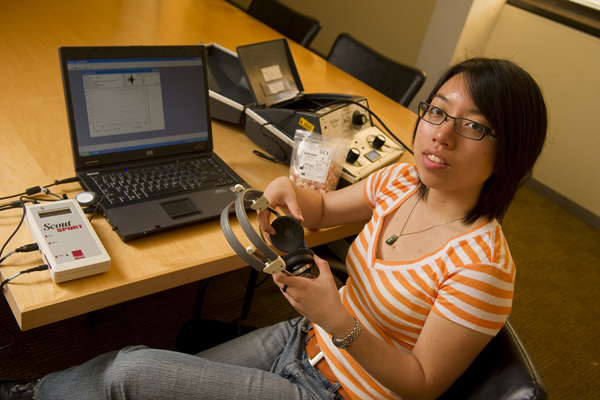
Olivia Tong is studying how hearing acuity is affected by headphones for music. Photo: Will Kirk/Homewoodphoto.jhu.edu
While shadowing a faculty mentor in a School of Medicine clinic, 21-year-old neuroscience major Olivia Tong noticed an alarming number of patients suffering from hearing loss. She knew that studies linked some hearing loss to exposure to loud industrial noise but wondered whether listening to music through earphones via an iPod or other personal music player might be having the same effect on some people. To find out, Tong asked 100 graduate and undergraduate students from the Johns Hopkins community to fill out a survey about their use of personal music players, including how much time they spent listening to music through headphones and their preferred volume, and their hearing health. Each subject then underwent a hearing assessment.
Questions for Olivia Tong:
What were you looking for, and what did you find?
I was originally investigating whether [listening to music on an MP3 player using] headphones could permanently damage hearing. But many studies had a similar objective and failed to find a critical volume or a time period of usage at which damage occurs. So now I’m studying the effect of headphones on hearing acuity by checking if hearing thresholds improve after 24 hours of abstaining from headphone usage. Thus far, the sample size is too small for a conclusive interpretation of the data.
Where do you go from here?
In August I’m going to medical school at the University of Buffalo. I hope to become a clinician-researcher.
What songs are on the top of the playlist on your own iPod or MP3 player?
“A.A. Bondy” by When the Devil’s Loose.
“Leonard Cohen” by Iodine.
“The Constantines” by Thieves.
“The Silver Jews” by Random Rules.
“Wolf Parade” by Grounds for Divorce.
Have the results of your research made you less likely to listen to music on your own personal music player?
I listen to music just as often as before I started the project, but I have lowered the volume a lot.
Sponsor Howard Francis says:
Olivia was captivated by the cases of hearing loss that she encountered while shadowing me in clinic. She worked in the temporal bone lab studying cadaveric ears as part of a study that she helped me conclude. Out of the blue she expressed a desire to study the impact of personal music players on the hearing status of fellow students. She posed a very well-constructed hypothesis, and I just couldn’t say no. I’m glad I didn’t. We went about forming a study group consisting of audiologists [Stacy Luna and Colleen Ryan] and an auditory scientist [Bradford May] to serve as consultants on the study. Olivia has a valuable combination of curiosity, capacity and persistence. It has been a pleasure working with her on this project.
—Lisa De Nike
Going for Baroque
Name: Brian Barone
Age: 21
Hometown: Ho-Ho-Kus, N.J.
Major: guitar performance, Peabody Conservatory
Faculty sponsor: Susan Weiss, Musicology Department, Peabody Conservatory
Project title: “Sources for Guitar Music in the Americas”
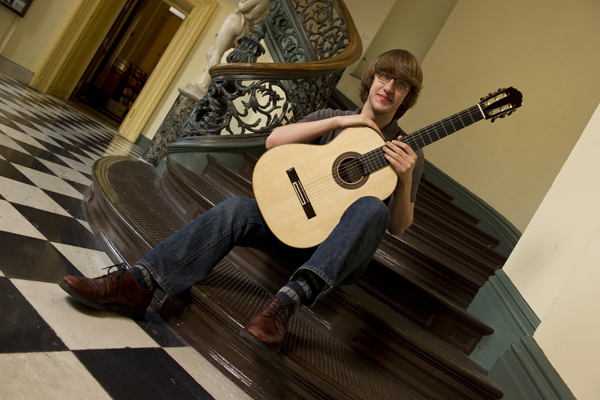
Brian Barone discovered an unknown 19th-century music manuscript in Mexico. Photo: Will Kirk/Homewoodphoto.jhu.edu
Classical guitarist Brian Barone, a junior at the Peabody Conservatory, originally planned to travel to Peru over spring vacation to study music written for the vihuela, a Renaissance-era instrument similar to the guitar. But somewhere along the line, he had to change his plans for his PURA project, whose goal was to find the connections between Europe and the New World as reflected in music for plucked-string instruments. Instead of going to Peru, he visited archives in Mexico City in search of guitar music from the Baroque period. His most intriguing find? An anonymous music manuscript from the 19th century, which he hopes to perform.
Questions for Brian Barone:
How did you become interested in the ancestors of the modern guitar and the music written for them?
When it comes to Early Music, classical guitarists are most used to hearing and playing arrangements or adaptations of pieces originally written for our instrument’s cousins: the lute and theorbo. When I took Professor Susan Weiss’ course on Early Music history, I learned that the story of the plucked-string family of instruments goes quite a bit deeper. Professor Julian Gray’s guitar literature course introduced me to the great trove of music for the Renaissance and Baroque guitars that most people tend to overlook.
The guitar came from Europe to America early on. How much is known about its history in the New World?
We know quite a bit about the guitar’s life in America, but there are still some really tantalizing mysteries to be solved. For instance, it’s pretty clear that the guitar rose to popularity quickly in the Americas and has stayed hyperpopular ever since. No more proof is needed than its ubiquity in Central and South American music or the explosion of guitar-driven rock ’n’ roll in the United States. As for what we don’t know, my favorite story is that of the Spanish Baroque composer Santiago de Murcia. Manuscripts of Murcia’s keep showing up in Mexico, but musicologists haven’t yet been able to figure out just how they got there.
Where did you do your research, and what did you find?
I did my research in Mexico City, where I had the chance to look in a few archives and libraries but worked primarily in the Archivo Musical del Cabildo Catedral Metropolitano de México. I found an anonymous manuscript from the 19th century containing six dances for solo seven-course guitar. I also found some evidence to suggest that these six dances were composed by the Mexican guitarist, composer, cellist, bassist, violinist and singer José María Bustamante.
What excites you about rediscovering music from an earlier time?
The best way that I can explain it is that it’s similar to the feeling that makes any of us want to explore somewhere new or makes us enjoy meeting new people. I’ll always remember my teacher remarking to me once that to sit down and compose a piece of music is a remarkable act of will. Someone who does that has something that she really, really wants us to know and feel. For me, it’s thrilling to think that in playing a piece of music I’m connecting to another person on that level, even though in some cases that person has been gone for hundreds of years.
What guitarist from the past would you most like to meet?
It’s maybe cheating to say this, but out of all the guitarists in history, I think I’d most like to meet Franz Schubert. Of course, Schubert is widely known as a pianist, composer and one of the four great masters of Viennese classicism, but he also apparently played guitar. Given his incredible genius and virtuosity at the piano, I’d love to find out what his guitar playing was like. Mostly though, I’d beg him to write us something for the guitar.
Sponsor Susan Weiss says:
Every so often—but not often enough, in my opinion—a student comes along who clearly shows an insatiable hunger for knowledge. Brian is one of them. He worked tirelessly with scholars here and abroad in an effort to gain access to the Cathedral archives in Cuzco, Peru. When it became clear that he had hit a brick wall, Brian brainstormed with his professors and external advisers and came up with a marvelous backup plan. With little time, he worked out a trip to Mexico City to consult sources there. As luck would have it, he was able to find some previously unpublished music that he will transcribe and perform at this year’s [PURA] ceremony. We won’t be disappointed.
—Richard Selden

